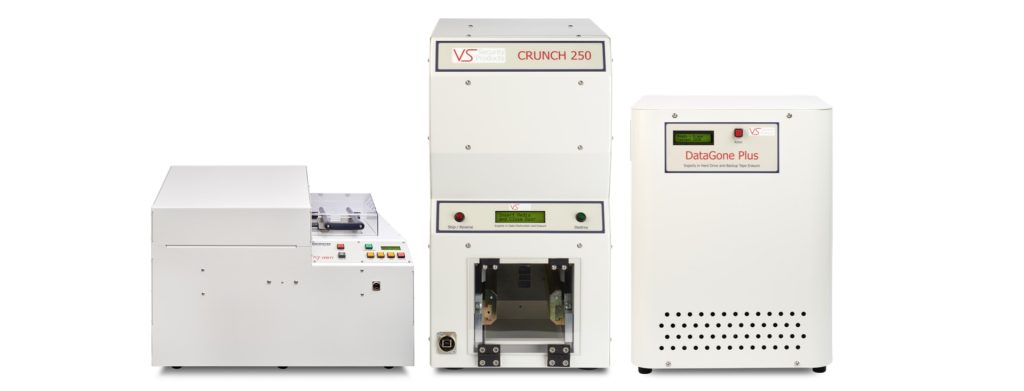What’s the difference between erasing data with software vs degaussing?

Businesses and organizations need to be aware of the key distinctions between hard drive degaussing and software erasing technologies because there are several.
Businesses can benefit from using software erasure tools to wipe hard drives, but there are also significant drawbacks that increase risk and uncertainty for those that opt for this form of volume erasure rather than degaussing.
The benefits and drawbacks of utilizing software to erase hard disks are discussed below, along with instances in which data degaussing using a hard drive degausser or a destroyer may be more suited.
Advantages of data-erasing software
- Frequently simple to use, and completes the task with a few mouse clicks.
- Depending on the license you purchase, it is affordable and may be used on a number of computers and laptops at the business.
- On the disk, existing data is erased by software.
Disadvantages with software erasing
- Every hard disk has faulty sectors, which the software cannot remove. The user would need to have the original bitmap of the hard drive in order to be able to delete these faulty sectors in a conventional hard drive because no overwrite software can access them. As a result, the information in those sectors will continue to exist and be accessible in the future.
- The data on the disk is not deleted by software. In actuality, it overwrites the existing data layer while adding a new one.
- Large portions of data will always remain on failed or malfunctioning hard drives that can’t be booted with software. These data chunks can’t be removed.
- A Ghost List, or G-List for short, is an internal auto-recovery feature that many hard disks have. With the use of this recovery program, the disk can automatically and secretly store your file and document data to prevent data loss. Even after you’ve used the software to delete the rest of the disk, this area of the hard drive can never be accessed by software programs and hence preserves important data information.
- You could be restricted in the size of disks you can wipe by the BIOS (Basic Input/Output System). There may be limitations where not all data can be deleted if you have upgraded to 1TB or 2TB drives or greater; this necessitates the use of different applications for various types of hard drive capacities.
- Hard drives are also available in SCSI and IDE standards, which means that the overwrite software you purchase sometimes needs to be able to work on both formats as one program cannot write on the other.
- No matter how many times software is used to overwrite data, the data cannot be physically removed from hard drives. This is problematic, especially for businesses and government agencies that need a complete erasing solution for sensitive data.
- Software erasure does not provide adequate protection against data theft and exposes companies and organizations to data breaches in the event that hard drives are discarded, sold, or used by other departments of the company without the same level of security.
- The procedures and solutions put in place by the data controller will be examined by auditors and insurers looking into concerns like data security and data breaches (Your business or organization). If software erasure is used as the main method of data removal, this could be viewed as an inadequate policy for data protection and erasure, putting you at risk of millions of dollars in damages and invalidating some insurance plans.
- Data erasure from a hard disk plainly has several drawbacks for the software user as well as for many companies and organizations who opt to employ this method exclusively. This might be a better way to wipe a disk for freelancers and small organizations, but in most circumstances software is not an option because of the high risk of data slipping into the wrong hands, the expense of prospective lawsuits, and the loss of insurance coverage.
On the other hand, degaussing has several benefits for organizations as well as drawbacks, which we will examine below:
Advantages of degaussing data
- The hard drive’s disk and all of its data will be magnetically erased; as a result, the data won’t be retrievable and won’t even be physically present on the disk.
- With the help of a hard drive degausser, the operator can thoroughly check the accuracy of their data erasure and provide visible logs to demonstrate that the volume of data was wiped.
- A hard drive degausser will guarantee that data is unrecoverable in any circumstance when a company or organization is audited regarding its data security protocols since it eliminates the chance of it being recovered by another corporation, a foreign government, or a criminal enterprise.
- Data degaussing gives organizations the opportunity to properly dispose of their hard drives for recycling as well as erase the data that is on the volume of the disk itself.
- No matter the format, age, or content of outdated systems that are no longer in use, including hard drives from the 1990s, tapes, and magnetic media, full erasure is the default setting. Degaussing completely erases all data from any such medium, which is impossible with conventional erasing software.
- Data degaussers are simple to use and can frequently completely wipe a disk in a matter of seconds. Degaussing significantly reduces the amount of time needed compared to software, which can take hours or even days depending on the quantity of drives.
- Degaussing and data destruction are both feasible, so operators have the choice to smash their own hard drives before disposal.
- And finally, degaussers are strongly advised for companies, especially government agencies, that demand the highest level of data security to safeguard trade secrets, personal data, and much more. (Our degaussers for example have NSA, NATO, and DoD approval.)
Disadvantages of degaussing
- Degaussing is not recommended for individual users or freelancers and can be more expensive for small businesses with few HDDs to wipe.
- Unlike software, which can be downloaded, degaussing equipment need a space to be kept (behind a desk or in an office).
- There are more benefits to degaussing than drawbacks, but the business owner must understand that degaussing is a comprehensive solution for data destruction as opposed to software, which is only an overwrite and is not a practical method of really deleting data from hard drives. Software might be enough depending on your use case, but for many people, the high danger of not being able to completely delete data from the disk is likely to be far more expensive for the owner when facing any type of data breach in the future.
In conclusion, using software to erase data may be an easy, affordable way for small businesses or individuals to erase a volume for re-use, but most of the time, businesses will be taking a huge risk with their data by choosing this option, and exposing themselves to costs in an era where data laws are imposing strict penalties for oversights in the data space – and companies are being held accountable for failures, often in public.
Explore our latest Knowledge Base articles to learn more about data destruction. You can also visit our product library to see what type of hard drive degaussers are available.

